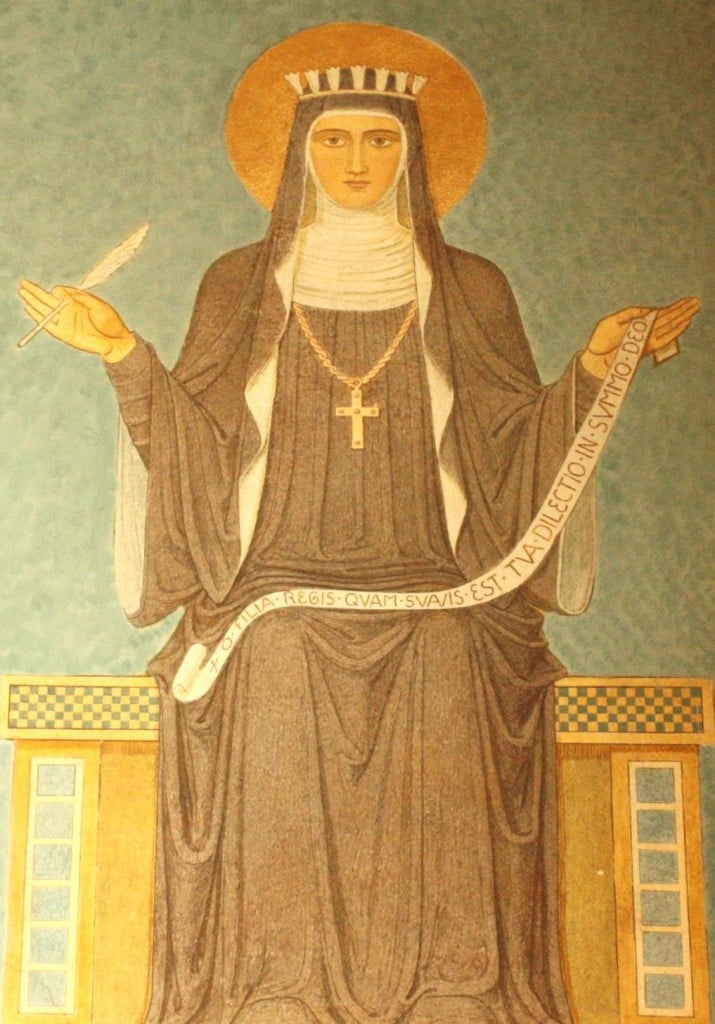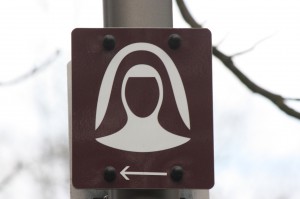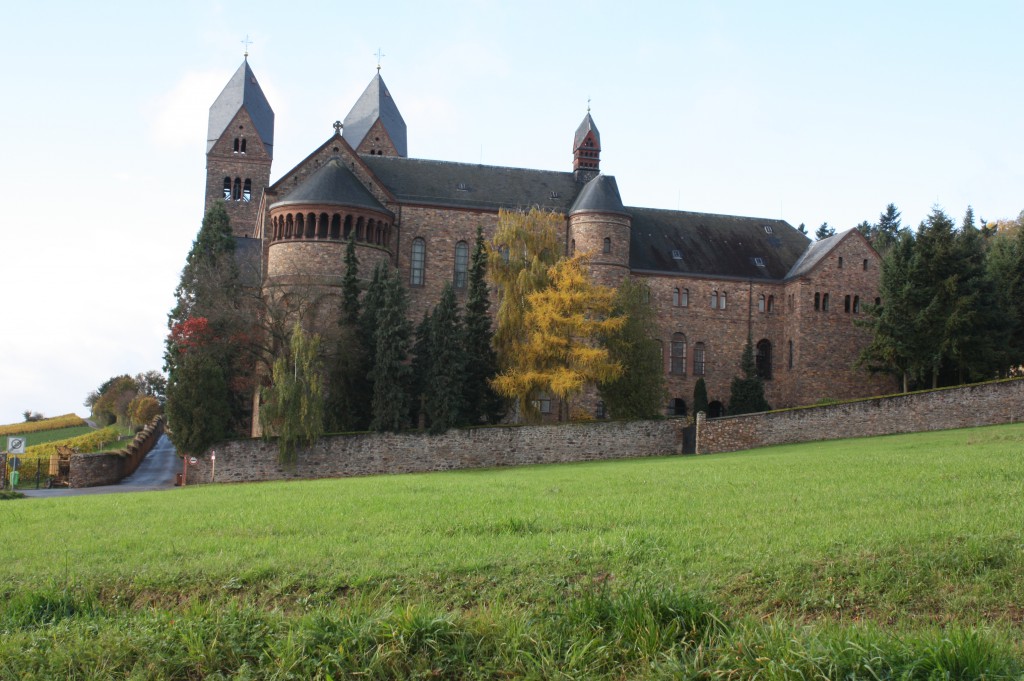
Today we cross the Rhine River (it only takes about five minutes by ferry) to explore Hildegard of Bingen’s legacy in the town of Rüdesheim, Germany. Remember I told you that Hildegard founded a second convent here when her Bingen abbey was full? Like her original abbey, her second one was destroyed hundreds of years ago. But I’m pleased to report that Hildegard’s legacy is flourishing at the Benedictine Abbey of St. Hildegard, which is built on a hill overlooking the towns of Rüdesheim and Bingen.
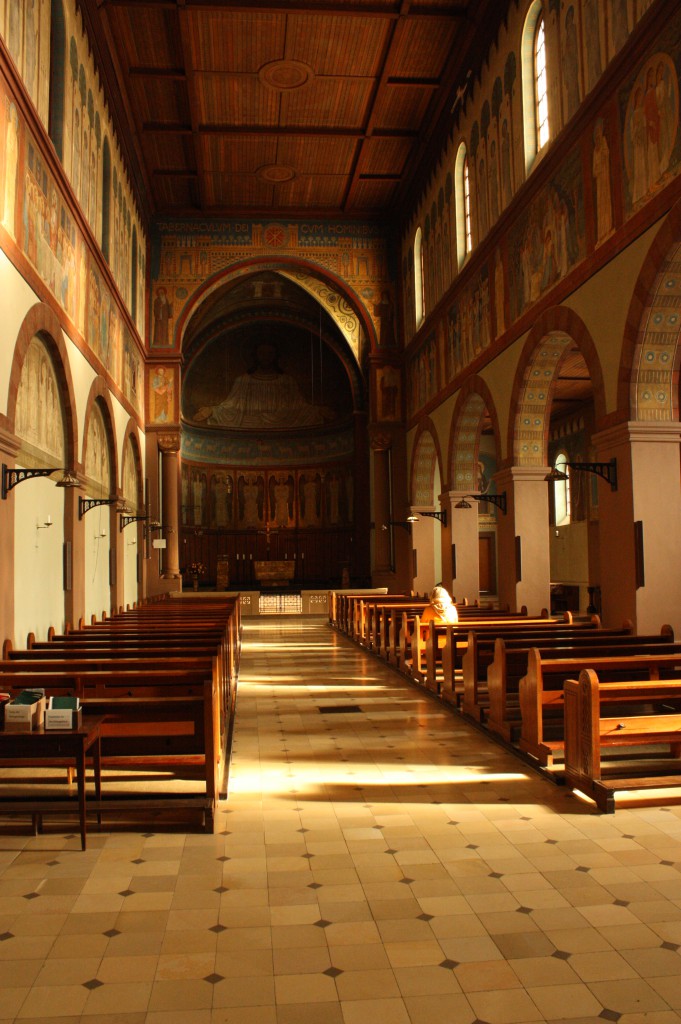
I’ve visited a lot of abbeys, and this is among the loveliest I’ve seen. Surrounded by vineyards, it has expansive views of the lush Rhine River valley. The building itself lives up to its dramatic setting. It was built between 1900-08 by Prince Karl of Lowenstein, who (during an era when Hildegard was largely unknown to the larger world) wanted to celebrate her spiritual legacy near the site of her original abbeys. He contacted an order of Benedictine nuns in Prague and made them an offer they couldn’t refuse: if a group of them would agree to move to the new abbey and name it after Hildegard, he would give it to them.
The Benedictine nuns happily moved into their new home and in their own quiet ways honored Hildegard’s memory, singing her music, researching her history, and welcoming the trickle of guests who came on the Hildegard Trail.
That trickle began to swell in the 1970s and has been growing every since. Today many pilgrims make their way to the Abbey of St. Hildegard, some for a brief visit and others for longer retreats. About 50 nuns live here, following the rhythms of Benedictine life that haven’t changed much since the days of Hildegard. In addition to hosting retreats, the nuns of the abbey have a variety of enterprises that support the community, including making wine from the vineyards and repairing books.
And what a home they have! The abbey is built in neo-Romanesque style, with a soaring interior lined with murals done in the Beuron style. I had never heard of this artistic style before visiting here, but I was quite taken by it. Though it originated in Germany in the nineteenth century, it draws on much older influences, particularly Egyptian art. The church’s interior is dominated by a figure of Christ with outstretched hands in its apse, while its northern wall has a series of exquisite murals depicting scenes from Hildegard’s life.
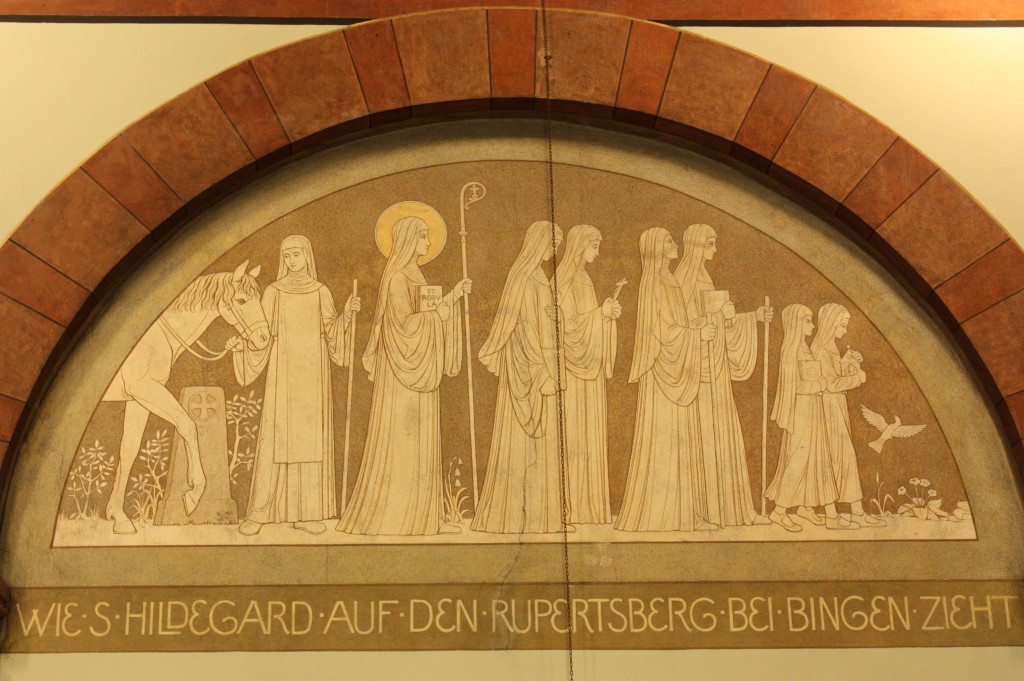
At the abbey I was pleased to get the chance to visit with Sister Ancilla, who has been part of the community for more than 40 years. She told of how surprised the nuns were a number of years ago when Pope Benedict XVI (who is German) mentioned Saint Hildegard in a speech. “We wrote to him and said that technically she wasn’t a saint because she had never been officially canonized,” she said.
Isn’t that funny? Despite Hildegard’s accomplishments and reputation in the church, she wasn’t actually a saint, a fact that even the Pope wasn’t aware of. But once this was known, Hildegard was put on the fast track to sainthood. Pope Benedict named her a saint in May of 2012, and in October of that same year he designated her as a Doctor of the Church, an honor given to saints whose lives and teaching are deemed particularly important (Hildegard was only the fourth woman saint to be so honored, joining St. Teresa of Avila, Catherine of Siena and Therese of Lisieux). And at the ceremonies at the Vatican honoring Hildegard, the main image of her was taken from a mural at the Abbey of St. Hildegard.
I would guess Hildegard said, “Well, it’s about time!”
Sister Ancilla believes that Hildegard’s message of wholeness and divine love is more important today than ever. “She believed that a human being is a unity, and that you can’t separate the soul from the body,” she said. “Her message was always about God’s love for us. There is a such a great need in the world today to hear that teaching.”
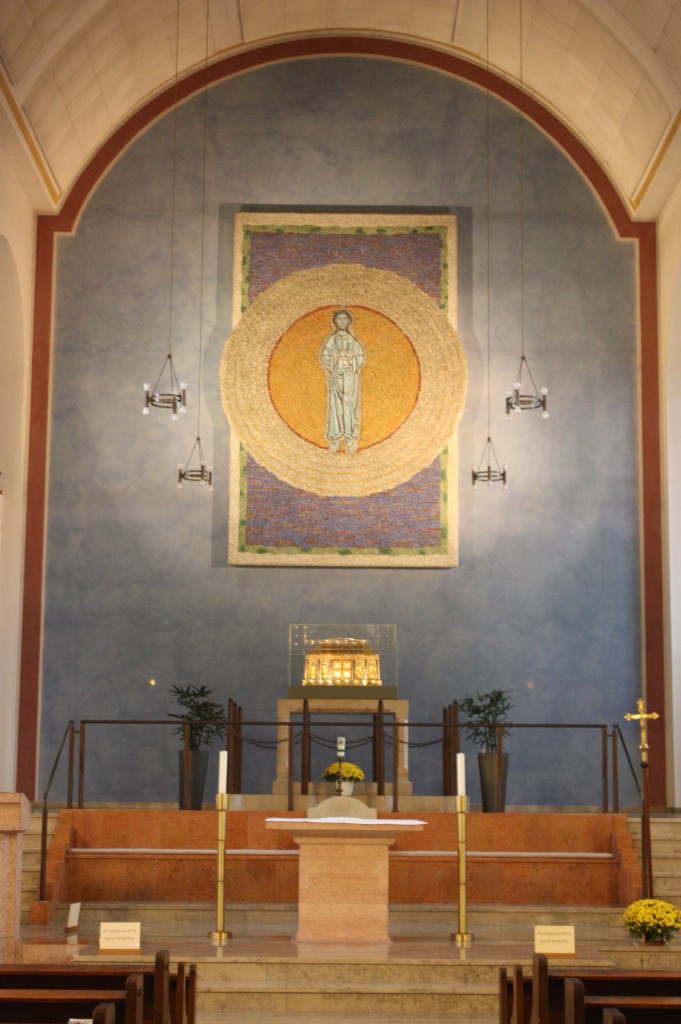
After leaving the abbey, we made our way down the hill to our final stop on the Hildegard Trail: the Parish and Pilgrim Church of St. Hildegard, which is built on the same spot where Hildegard’s second abbey once stood. In her day this was known as the Eibingen Abbey, which lasted until 1802. The current church building was constructed in 1935.
As we entered, our eyes were immediately drawn to the immense mosaic above the altar. Made of 150,000 small pieces of glass, it depicts Hildegard’s vision of the Holy Trinity, showing the figure of a man surrounded by two concentric circles, one of gold and one of silver. The man is Christ, the silver circle is God, and the golden circle is the Holy Spirit. What an unusual image of the Trinity! I’ve never seen another altar quite like it.
Below the mosaic is a golden box containing the relics of Hildegard (while there are a few more of her relics kept here and there, the majority rest in this case). The reliquary is inscribed with a verse from Isaiah: “He hath clothed me with the garments of salvation and with the robe of joy He hath covered me: He hath crowned me with a diadem as a bride, as a bride whom He hath adorned with His jewels.”
And so we come, at last, to the end of Hildegard’s story. Healer, mystic, saint, musician and feather on the breath of God. I hope this digital pilgrimage has whetted your appetite to learn more. (Below you’ll find a few suggestions for further reading as well as a short video on Bingen.) But Hildegard herself gets the last word, in this passage from one of her letters:
Walk through the valley of humility and know peace. Lose your titanic, hard-to-satisfy ego. A greedy self-esteem is just a steep mountain you’ll find dangerous to climb. It’s also tricky (if not impossible) to come down from such heights, and anyhow the summit is too small for community. Focus on Love’s splendid garden instead. Gather the flowers of humility and simplicity of soul. Study God’s patience. Keep your eyes open.
To learn more about Hildegard of Bingen:
Carmen Acevedo Butcher’s Hildegard of Bingen, Doctor of the Church: A Spiritual Reader
provides a good historical overview, with selections from her works as well as commentary. Victoria Sweet’s memoir God’s Hotel: A Doctor, a Hospital, and a Pilgrimage to the Heart of Medicine is by a doctor who became fascinated by Hildegard and her writings on medicine. Sweet ended up getting a PhD in Hildegard while continuing to practice medicine in a charity hospital in San Francisco, where she incorporated some of Hildegard’s wisdom into her treatments. Vision – From the Life of Hildegard von Bingen
is a German-made film that is well worth watching, though I disagree with its characterization of Hildegard in some ways. And Matthew Fox gets credit for starting the current resurgence of interest in Hildegard with his Illuminations of Hildegard of Bingen


